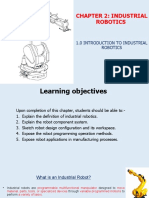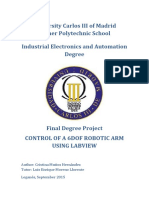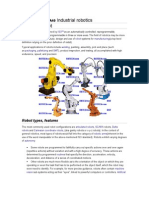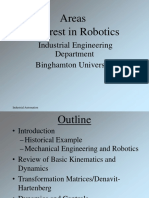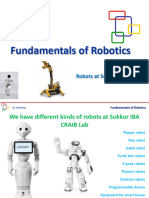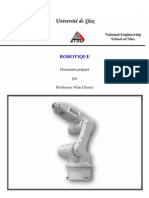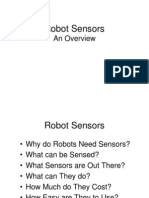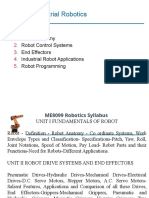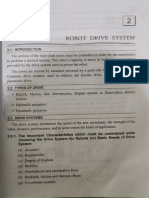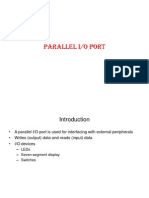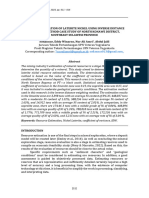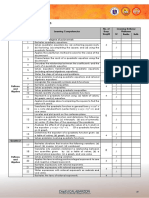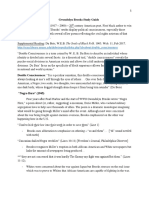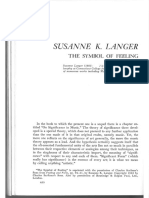ESE616
INDUSTRIAL AUTOMATION AND ROBOTICS
CHAPTER 3
Introduction to Robotics
�Historical Overview
The word "robot" originated from the Czech
word robota, meaning forced labour. It was
introduced by playwright Karel Capek in 1921.
Robot Maria appeared in the 1927 movie
Metropolis.
The word robotics appeared in Isaac Asimov's
science-fiction story "Runaround" in 1942.
Isaac Asimov
�Historical Overview
In 1954, George C. Devol files a patent for
the first programmable robot, which capable of
performing industrial tasks.
In 1961, G.C. Devol with Joseph Engelberger
works for Unimation to develop the first
industrial robot, called Unimate. It used
hydraulic actuators and was programmed in
joint-coordinates.
�Historical Overview
In 1962, General Motors installed a Unimate
robot on one of its automobile assembly lines.
In 1969, Victor Scheinman from Stanford
University, designed the robot arm called
Stanford Arm, an all electric, 6-axis
articulated robot.
Stanford Arm
Unimate
�Historical Overview
In 1977, Scheinman sold his design to
Unimation, which further developed it with
General Motors, into the PUMA robot.
In 1980s, the robot industry enters into a
maturing period as industry recognizes that
robots are integrated part of automation.
�Historical Overview
In 1977, Scheinman sold his design to
Unimation, which further developed it with
General Motors, into the PUMA robot.
In 1980s, the robot industry enters into a
maturing period as industry recognizes that
robots are integrated part of automation.
�End
Historical Overview
�Basic Robotics
There is no standard definition that can be agreed upon
by all, to describe the meaning of robot. Hence, to pick
which machines can qualify as robots is not so straight
forward practice.
However, there is a common understanding among many
people that a robot must have several essential
characteristics before it can be accepted as robot. The
characteristics are as follows:
Able
Able
Able
Able
Able
to
to
to
to
to
move around in its environment
sense and manipulate its environment
power itself
display some form of intelligent
imitate human or animal behaviour
�Basic Robotics
Basically, you may imagine a robot as a mechanical device
that can moves and performs automated (semi- or fully-)
tasks, with electronic control system at its heart.
The robot is controlled by a stored program and is
reprogrammable, meaning that the program can be
changed to fit the requirements of different jobs.
The robot should be multi-functional, meaning that it
able to perform more than one function. The same robot
can be used to perform varying jobs.
�Basic Robotics
Robotics is the science and technology of robots,
requiring multi-disciplinary fields, and to name several;
Mechanical engineering
Electrical and electronics engineering
Computer science and computer engineering
Sensory technology
Control theory
Materials science
Mathematics, Physics and Biology
Specific knowledge involves are; Dynamic, Kinematic,
Feedback Control, Sensors and signal conditioning,
Actuators and power electronics, Computer interfacing,
Software and programming.
�Basic Robotics
Various types of robots are in use today, and they may
be categorized in a number of ways, for example based
on their number of degree of freedom, types of
structure, types of applications, degree of autonomous,
and etc. However, here we divide them into two main
categories, which reflects their big area of applications;
Industrial
Non-industrial
Mostly manipulator types, and specifically
used in manufacturing operations, that are
automatically controlled, reprogrammable,
multipurpose, programmable, and have in
three or more axes.
Other robots that are not used in
manufacturing plants, exist in sectors
such as agriculture, medical, military,
etc.
�Industrial Robots
The Robot Industries Association (RIA formerly Robot
Institute of America) developed the following definition
to help identify machines that can be classified as
industrial robots:
A robot is a reprogrammable, multifunctional manipulator
designed to move material, parts, tools, or specialized
devices through variable programmed motions for the
performance of a variety of tasks.
Based on the ISO/TR/8373-2.3 standard, an industrial
robot is officially defined as:
Automatically controlled, reprogrammable, multipurpose
manipulator programmable in three or more axes, which
may be either, fixed in place or mobile for use in
industrial automation applications.
�Industrial Robots
The worldwide manufacturing sector continues to
established as the main users of robots. The total unit
sales of world industrial robot for the year 2008 was
113,345 units, with a value of about US$6.2 billion. It
is projected that for the period between 2010 and 2012,
there will be an increase of about 15% per year.
For the year 2008, Japan maintains as the country with
largest installation of new robots, with about 33,100
installations. North America is second with 16,200
installations, and third is Germany with 15,200
installations.
36% of the industrial robots were installed for the
automotive manufacturing. Electrical/electronics industry
account for about 11.8%. Chemical, rubber and plastics
industry account for 11%. Other biggest users are metal
products, machinery and food industries.
�Industrial Robots
The market share for industrial robots based on the
types of robots are as follows;
Articulated
60%
robot with rotary joints (e.g. a legged robot or an
industrial robot). Articulated robots can range from
simple two-jointed structures to systems with 10 or
more interacting joints.
Gantry (Cartesian)
22%
an industrial robot whose three principal axes of control
are linear (i.e. they move in a straight line rather than
rotate) and are at right angles to each other. The
simplest application is used in milling and drawing
machines where a pen or router translates across an x-y
plane
�Industrial Robots
The market share for industrial robots based on the
types of robots are as follows;
SCARA
13%
stands for Selective Compliant Assembly Robot Arm or
Selective Compliant Articulated Robot Arm. The arm is
slightly compliant in the X-Y direction but rigid in the Z
direction, hence the term: Selective Compliant. This is
advantageous for many types of assembly operations, i.e.,
inserting a round pin in a round hole without binding.
Cylindrical
4%
the motion of this robot is basically up and down at the
main part of the body and circular at the base. The
motion is perform by extending a cylinder that is built
into the arm.
�Industrial Robots
Area of application
Welding
Spray painting
Assembly
Palletizing and material handling
Finishing
Inspection and testing
�Industrial Robots
Welding
The most popular industrial applications for robots,
especially in the automotive industry.
Types of welding: Spot and Arc welding.
�Industrial Robots
Spray painting
It can provide consistency (uniform & quality),
repeatability, & less waste (cutting cost).
�Industrial Robots
Assembly
Tasks are tedious and repetitive in nature
Mechanical parts (small parts less than 1 kg)
Electronic parts (auto insertion on PCB, wafer
handling, soldering, harddisk assembly)
�Industrial Robots
Palletizing and material handling
Loading & unloading material onto pallets
For casting, molding, forging, stamping, machine
tool, etc.
�Industrial Robots
Finishing
Grinding and polishing
�Industrial Robots
Inspection & testing (measurement)
Visual inspection, Ultrasonic inspection, X-ray
inspection
�Industrial Robots
Inspection & testing (measurement)
Automated visual inspection
Car industry
Welding Inspection
For automobile manufacturing
Ceramic filters inspection, colour
measurement on dash board
components
�Service Robots
The use of robots in other areas has been growing, and
this non-industrial robots are grouped into a category
called Service Robots. But difficult to define because the
multitude of forms and structure of the robot as well as
the application areas.
A provisional definition by IFR (International Federation
of Robotics) describe a service robot as:
A service robot is a robot which operates semi- or fully
autonomously to perform services useful to the well-being of
humans and equipment, excluding manufacturing operations.
With this definition, manipulating industrial robots could
also be regarded as service robots, provided they are
installed in non-manufacturing operations. Service robots
may or may not be fitted with a manipulator arm
structure, and often that, the service robots are mobile.
�Service Robots
The nature of applications for service robots are varied
and they are used in unstructured and dynamic
environments, such as construction, forestry, agriculture,
mining, subsea, highways, search and rescue, military,
space, etc. The robots perform non-repetitive tasks and
objective sensing as well as self-navigation in random
environments.
20,000 units are being used in defense, rescue and
security applications, which accounted for more than 30%
of total service robots for professional use sold up until
2008.
Other sectors for service robots are milking (23%),
cleaning (9%), medical and underwater (8%), construction
and demolition (7%), mobile platforms for general use
(6%), logistic systems (5%).
�Service Robots
Service robots may further be divided into 2 sub-groups,
one for professional use and second for personal and
domestic use.
The areas for service robots for professional use are:
Field robotics
Professional cleaning
Inspection and maintenance systems
Construction and demolition
Logistic systems
Medical robotics
Defense, rescue & security applications
Underwater systems
Mobile platforms in general use
Robot arms in general use
�Service Robots
The areas for service robots for personal and domestic
use are:
Domestic tasks (including vacuum cleaning and lawnmowing)
Entertainment robots (including toy robots and hobby
systems)
Handicap assistance
Automated personal transportation
Home security and surveillance
Humanoid robots
�Service Robots
Field Robots
Precision farming using autonomous field operations.
Vegetables harvesting
Autonomous tractor with a
centered mower
Milking robot
�Service Robots
Cleaning Robots
Street cleaning, Window cleaning, Underwater (pool)
cleaning, Office cleaning.
Under water Cleaning
(Urakami)
Street cleaning (Figla)
Window Cleaning
(Gecko, SERBOT AG)
Pool Cleaning (Verro
600, iRobot)
�Service Robots
Inspection and maintenance systems
Compact Magnetic
Wheeled Inspection
Robot with High
Mobility (Magnebike,
ETH ZURICHALSTOM)
Robot inspect wind
turbines
Eddy current test robot for cooling water
pipelines, using video and laser
(Inspector 6000, INSPECTOR SYSTEMS)
�Service Robots
Construction and demolition
Most construction jobs are repetitious, laborintensive, and dangerous, which perfectly suited for
robot automation.
From laying brick, to handling delicate windows and
insulation. Some robots have even been used to
build prefabricated walls, and can vertically
dispense concrete.
Excavator (Brokk)
Remote operation Demolition
robot using radio control
�Service Robots
Logistic systems
Moving materials, goods and people.
At present less than 15% of the end-to-end
distribution process has been considered for
automation.
There is a large demand for the development and
integration of robot-systems within logistics with
the aim being to make the processes of logistics
more efficient and the work easier.
�Service Robots
Medical Robotics
Shared-control robotic systems assist surgeons
performing surgery. The surgeon does most of the
work, while the robotic system monitors the
surgeons performance and provide active support.
Pharmacy automation
Prepares a robotic surgery
system for heart surgery
Surgeon using a Photomedix electro-mechanical
manipulator
�Service Robots
Defense, rescue & security applications
Unmanned Aerial Vehicles (UAVs) Surveillance &
reconnaissance, navigation
Unmanned Ground Vehicles (UGV) Surveillance &
reconnaissance
Bomb detection and disposal
Search and rescue
Rescue Robot (T-52, TmSuk)
Bomb disposal
�Service Robots
Underwater systems
Deep water remotely operated vehicle (ROV).
Applied in offshore oil & gas industry to assist in
the development of offshore oil fields.
Inspection of subsea structures, pipeline and
platforms. Locate shipwrecks and recover material
from the sea floor.
Used widely by the science community to study the
ocean.
�Service Robots
Space Exploration
Deep water remotely operated vehicle (ROV).
Applied in offshore oil & gas industry to assist in
the development of offshore oil fields.
Inspection of subsea structures, pipeline and
platforms. Locate shipwrecks and recover material
from the sea floor.
Used widely by the science community to study the
ocean.
�Service Robots
Robot arms in general use
Used in other than the industrial manufacturing
sector.
Educational
Agriculture, Grapevine Pruner
(3-D vision technology)
�Service Robots
Domestic tasks
Vacuum Cleaning
Lawn Mowing
LG RoboKing
(V-R4000)
ECO-G158
The
Future
�Service Robots
Entertainment robots
Toy robots, hobby, and games.
�Service Robots
Handicap Assistance
iBot 4000
Wheelchair
Powered assistive Limb/suits
Legged human carrier
Elevating Wheelchair
�Service Robots
Automated personal transportation
Toyota
Segway
Honda
�Service Robots
Home security and surveillance
Internet-enabled, Mobile phone-controlled, GPSenabled, in-home care & security.
Internet-enabled Mobile
phone-controlled robot
for in-home care &
security (Fujitsu, MARON1)
Rovio, mobile
webcam
Monitor 1 mile area using
GPS (Securo)
�Service Robots
Humanoid Robots
Imitates humans (humanoid) & animals bio-mechanics
�Mobile Robots
�Mobile Robots
MiRoC
�Mobile Robots
Robocon
�Mobile Robots
SmartCar
�Mobile Robots
�Robot Architecture
A robot architecture primarily refers to both
the software and hardware structure of the
robot.
Examples of a robots hardware structure are;
Fixed base or mobile base
2- or more axis
Wheeled or legged or flying mobile
With or without manipulator arm, etc.
Examples of a robots software structure are;
C language on 8-bit or 16-bit platform
Software polling or interrupt
Opened-loop or Closed-loop control
PID or fuzzy logic scheme
Single-tasking or multi-tasking, etc.
�Robot Architecture
A physically functional robot is based on
proper integration of the hardware and
software structures.
Robots may have physical appearances and
functionalities that are very different from
one another, but their architectures are
formed from some common elements;
Controller
Sensors
Actuators
Software
User interface
Power system
Base and linkages
�Robot Architecture
Controller is central to the robots control system,
which process the program with aim to control the
robots motion
Sensors measure some parameters from the environment
& these data are fed back to the controller for analysis
Actuators produce movement for the robot in the
form of navigation and manipulation
The program commands robot to do various functions
such as; Navigation, Manipulation, Sensing,
Communication, Data processing
To sent and receive input from
user to controller
Primary source of power that supplies
energy to the control systems,
actuators & sensors.
Provides base and physical structure in
the forms of manipulator, wrist & endeffector
Controller
Sensors
Actuators
Software
User interface
Power system
Base and linkages
�Robot Architecture
The Technology Fields
Controller
Sensors
Actuators
Software
User interface
Power system
Base and linkages
Electrical and Electronics
(hardware)
Software
Electrical Power (Hardware)
Mechanical structure
(Hardware)
�Robot Architecture
Controller
Sensors
Actuators
Software
User interface
Power system
Base and linkages
User Interface
Software
Sensors
Controller
Power
Source
Power
Conversion
Actuators
Base & linkages
The blocks representing a basic
robots architecture
�Robot Architecture
Controller
Sensors
Actuators
Software
User interface
Power system
Base and linkages
A mobile robot
�Robot Architecture
Controller
Sensors
Actuators
Software
User interface
Power system
Base and linkages
Hydraulic-electrical
Power Unit
Controller
(Software and user
interface)
Actuators at
every axis
Base
An industrial robot
arm
�Robot Architecture
Having common elements for their
architectures, robots may be categorised
based on their types of base structure. Two
types of structures can be established.
Fixed base
manipulator robot
The base is fixed to the floor and the
manipulator can moves around in
the workspace within the reach from
the base to perform tasks.
Mobile base
robot
The base has a form of
locomotion for the robot to
move around in the environment
to perform tasks.
�Robot Architecture
Different types of fixed base manipulator
robots:
Spherical
Cartesian
Articulated
Cylindrica
l
�Robot Architecture
Different types of mobile base robots:
Wheeled
Legged
�Robot Architecture
Different types of mobile base robots:
Aerial (Flying)
Submersible (in/on water)
�Robot Architecture
The primary function of a robot is to perform
appropriate movements according to its
required application. A robot can execute two
types of motions:
Manipulation: movement of a manipulator to do
specific tasks in its environment.
Navigation: movement of a mobile base robot in
its environment.
Manipulation
Navigation
�Robot Architecture
The primary function of a robot is to perform
appropriate movements according to its
required application. A robot can execute two
types of motions:
Manipulation: movement of a manipulator to do
specific tasks in its environment.
Navigation: movement of a mobile base robot in
its environment.
A manipulator and a mobile platform can merge
together into a single robot.
Manipulation
Navigation
�Robot Architecture
The robots movements are controlled by the
internal controller, directed through the
software programmed into it. The controller
could store several different programs and can
be modified if necessary.
Other functions can be programmed and
processed by the controller are such as;
Sensing the environment
Processing data and making decision
Communication between user or other devices
�Robot Architecture
Controller is central to the robots control
system, which processes the program to perform
the desired tasks.
The program controls the actuators to produce
output action (motion) on the robot, in the form
of navigation and manipulation.
Input
(Desired
Tasks)
Program
Controller
Navigation and/or
Manipulation
Actuators
Plant
Output
(Motion)
�Robot Architecture
Sensors are used to measure the performances
of the output, and also to measure some
parameters from the environment. These data
are fed back to the controller for analysis and
decision making.
Input
(Desired
Tasks)
Program
Controller
Navigation and/or
Manipulation
Actuators
Sensors
Position, orientation,
obstacles, speed, light, etc.
Plant
Output
(Motion)
�Robot Architecture
Controller may receive input from user or
operator through a user interface.
The controller is equipped with input and output
ports to send signal to actuators and receive
signal from sensors or user.
User Interface Program
Input
(Desired
Controller
Tasks)
Navigation and/or
Manipulation
Actuators
Sensors
Position, orientation,
obstacles, speed, light, etc.
Plant
Output
(Motion)
�Robot Architecture
The types of controller to choose will depends
largely on the functions and nature of the robot
tasks. Some are more complex than the others.
A complex motion control scheme demands for
high performance processors to process them, or
a basic motion can be controlled by a low end
basic processors.
Besides embedded controller, PLC and PC can be
used as controllers for robots.
�Robot Mechanism
A robot structure is located relative to the
ground by a fixed or mobile base.
A fixed base manipulator consists of several
rigid parts that are connected in series and can
move through space. The rigid parts are called
links. A robot can has many links.
Two links are connected
together by a joint, or
also known as axis of
motion. Actuators are
placed at the joints to
allow relative motion of
two links.
Link 3
Link 2
Link 1
Joint 3 (Axis 3)
Joint 2 (Axis 2)
Joint 1 (Axis 1)
�Robot Mechanism
Link 4
Link 5
Link 3
Link 2
Link 1
Base (fixed)
Example with an
articulated robot
arm
Link 3
Link 2
Link 1
Joint 3 (Axis 3)
Joint 2 (Axis 2)
Joint 1 (Axis 1)
�Robot Mechanism
A mobile base robot contains links and joints
between the base and the locomotion medium
(e.g. wheels, legs, propeller, etc).
Similarly, actuators may be placed at the joints
to allow relative motion (mobility) of the base.
Joint 1
Wheeled Mobile
Robot
Base (mobile)
Joint 3
Joint 2
�Robot Mechanism
The joints in a robot are normally restricted to
one degree of freedom. That means, each axis
equals one degree of freedom.
There are 2 basic types of joints: Revolute and
Prismatic joints.
Most electric motors could produce revolute
motion.
Revolute Joint: Produces a
rotational motion along the axis
with some angular velocity
�Robot Mechanism
The joints in a robot are normally restricted to
one degree of freedom. That means, each axis
equals one degree of freedom.
There are 2 basic types of joints: Revolute and
Prismatic joints.
Hydraulic and pneumatic actuators naturally
produce linear motion, but there are also
electric motors that can generate linear motion.
Prismatic Joint: Produces a
linear or sliding motion
along a joint axis with
some linear velocity
�Robot Mechanism
The degree to which the joints can move
(revolute and prismatic) in any direction is called
the degree of freedom (DOF).
It refers to the number of different ways in
which a robot manipulator arm can move to
position and orientate the end-effector.
For a typical manipulator arm robot, the number
of joints equals the number of degrees of
freedom. Each joint position is usually defined
with a single variable.
A robotics system with several bodies (links)
would have a combined DOF that is the sum of
the DOFs of the bodies, less the internal
constraints they may have on relative motion
�End

